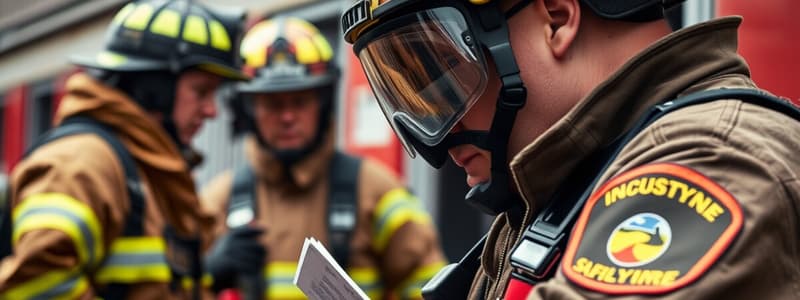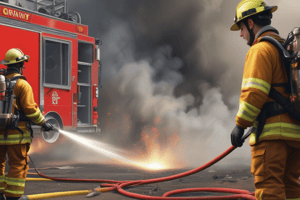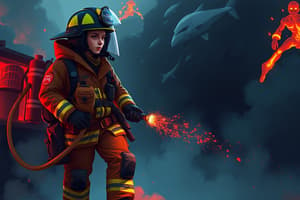Podcast
Questions and Answers
What is one major responsibility of the incident safety officer (ISO) during postincident activities?
What is one major responsibility of the incident safety officer (ISO) during postincident activities?
- To provide physical support to firefighters
- To conduct live training exercises
- To document incident activities for future analysis (correct)
- To supervise the fire scene removal of equipment
Which of the following is a typical cause of postincident injuries?
Which of the following is a typical cause of postincident injuries?
- Chemical imbalances and thought patterns (correct)
- Inadequate training prior to the incident
- Negligence during equipment maintenance
- Exhaustion from extended firefighting
What is the 'let-down trap' in the context of postincident thought patterns?
What is the 'let-down trap' in the context of postincident thought patterns?
- A mental state leading to inattentiveness and potential injuries (correct)
- A process to ensure effective debriefing after an incident
- A stage where firefighters proactively engage in injury prevention
- A stage where firefighters feel celebratory after a successful operation
How can the ISO mitigate the risk of inattentiveness among firefighters after an incident?
How can the ISO mitigate the risk of inattentiveness among firefighters after an incident?
What happens to a firefighter's metabolism after the end of an incident, according to the information provided?
What happens to a firefighter's metabolism after the end of an incident, according to the information provided?
What mental state is characterized by the firefighters' reflective thoughts immediately after an incident?
What mental state is characterized by the firefighters' reflective thoughts immediately after an incident?
What action can help firefighters regain focus during the pick-up phase after an incident?
What action can help firefighters regain focus during the pick-up phase after an incident?
Why is accurate information collection crucial for incident postanalysis?
Why is accurate information collection crucial for incident postanalysis?
What is the purpose of the Postincident Analysis (PIA)?
What is the purpose of the Postincident Analysis (PIA)?
Which of the following is NOT a requirement for the ISO's involvement in the PIA?
Which of the following is NOT a requirement for the ISO's involvement in the PIA?
When does the PIA become secondary to accident investigation?
When does the PIA become secondary to accident investigation?
What is the recommended approach for ISA during the PIA process?
What is the recommended approach for ISA during the PIA process?
What type of incident would trigger a formal (written) PIA?
What type of incident would trigger a formal (written) PIA?
What is a close call or near miss defined as?
What is a close call or near miss defined as?
Which aspect of incidents should the ISO focus on during an investigation?
Which aspect of incidents should the ISO focus on during an investigation?
What is one of the primary goals of incident documentation during the PIA process?
What is one of the primary goals of incident documentation during the PIA process?
What does NFPA 1561 specifically require the ISO to investigate?
What does NFPA 1561 specifically require the ISO to investigate?
Which type of questions should be avoided during the PIA discussions?
Which type of questions should be avoided during the PIA discussions?
In what component of the process is it essential to collect information while on-scene?
In what component of the process is it essential to collect information while on-scene?
What can a recurring problem identified by the ISO lead to?
What can a recurring problem identified by the ISO lead to?
How should the incident commander and ISO collaborate during the PIA?
How should the incident commander and ISO collaborate during the PIA?
What is the general attitude that the ISO should adopt during the PIA?
What is the general attitude that the ISO should adopt during the PIA?
What is the purpose of initiating stress exposure protocols by an ISO?
What is the purpose of initiating stress exposure protocols by an ISO?
How does defusing differ from debriefing in incident response?
How does defusing differ from debriefing in incident response?
What is the primary focus of a postincident analysis (PIA)?
What is the primary focus of a postincident analysis (PIA)?
Which resource is NOT explicitly mentioned for addressing occupational stress?
Which resource is NOT explicitly mentioned for addressing occupational stress?
What should ISOs avoid when conducting an accident investigation?
What should ISOs avoid when conducting an accident investigation?
What is considered a critical component of the accident chain in investigations?
What is considered a critical component of the accident chain in investigations?
Why is it recommended that ISOs document their actions and observations?
Why is it recommended that ISOs document their actions and observations?
When should a formal PIA be utilized?
When should a formal PIA be utilized?
Which of the following is a key responsibility of the ISO during a PIA?
Which of the following is a key responsibility of the ISO during a PIA?
Which action is explicitly mentioned as part of the ISO's role during an incident?
Which action is explicitly mentioned as part of the ISO's role during an incident?
What characterizes the formal agenda of a debriefing session?
What characterizes the formal agenda of a debriefing session?
Which scenario requires that the ISO recuse himself from an investigation?
Which scenario requires that the ISO recuse himself from an investigation?
What aspect does the NFPA 1500 regulation specifically require from ISOs?
What aspect does the NFPA 1500 regulation specifically require from ISOs?
What is the main purpose of conducting a barrier analysis after an incident occurs?
What is the main purpose of conducting a barrier analysis after an incident occurs?
Which of the following best describes an atypical stressful event (ASE)?
Which of the following best describes an atypical stressful event (ASE)?
What should be omitted from the recommendation step in incident analysis?
What should be omitted from the recommendation step in incident analysis?
Which matrix can assist in identifying human performance error precursors?
Which matrix can assist in identifying human performance error precursors?
What characterizes the defusing process in incident stress management?
What characterizes the defusing process in incident stress management?
What requirement does NFPA 1500 impose on fire departments regarding behavioral health?
What requirement does NFPA 1500 impose on fire departments regarding behavioral health?
Which of the following is NOT a sign of incident stress?
Which of the following is NOT a sign of incident stress?
What is the primary goal of an ISO in preventing accidents?
What is the primary goal of an ISO in preventing accidents?
What role does the ISO play in supporting an Atypical Stressful Event (ASE) exposure program?
What role does the ISO play in supporting an Atypical Stressful Event (ASE) exposure program?
Which situation would require the ISO to recuse themselves from the investigation process?
Which situation would require the ISO to recuse themselves from the investigation process?
How should an ISO handle human mistakes during an investigation?
How should an ISO handle human mistakes during an investigation?
What is a key role of the ISO regarding occupational stress?
What is a key role of the ISO regarding occupational stress?
Which of the following events generally requires an investigation?
Which of the following events generally requires an investigation?
What does the hazard MEDIC action model emphasize for the ISO?
What does the hazard MEDIC action model emphasize for the ISO?
Which statement best describes the purpose of steps taken after an incident?
Which statement best describes the purpose of steps taken after an incident?
What does ASD stand for in relation to incidents experienced by firefighters?
What does ASD stand for in relation to incidents experienced by firefighters?
Why is investigating accident causation vital according to the ISO's role?
Why is investigating accident causation vital according to the ISO's role?
What distinguishes an atypical stressful event (ASE) from a regular incident?
What distinguishes an atypical stressful event (ASE) from a regular incident?
During the reconstruction of an incident, which of the following is NOT a category for information collection?
During the reconstruction of an incident, which of the following is NOT a category for information collection?
What is a common result if post-traumatic stress disorder (PTSD) remains untreated?
What is a common result if post-traumatic stress disorder (PTSD) remains untreated?
What characterizes the recommendations made by the ISO after an investigation?
What characterizes the recommendations made by the ISO after an investigation?
Why might outside agencies become involved in an investigation?
Why might outside agencies become involved in an investigation?
Flashcards are hidden until you start studying
Study Notes
Paying It Forward and Postincident Activities
- Lessons learned from close calls should inform training, aiding in the prevention of future incidents.
- War stories from experienced firefighters serve as crucial teaching tools in training academies.
- Incident Safety Officer (ISO) plays a pivotal role in capturing and documenting incidents for postincident analysis.
Postincident Thought Patterns
- Reflective thought patterns after incident control can lead to inattentiveness and increased injury risk for firefighters.
- The "let-down trap" phenomenon occurs as firefighters shift from intense activity to routine tasks, triggering mental fatigue.
- ISOs must remain vigilant during postincident activities to combat inattentiveness through reminders and encouragement for focus.
Chemical Imbalance
- The end of an incident can induce chemical imbalances in firefighters due to relaxation and exhaustion, affecting decision-making and clarity.
- ISOs should recognize fatigue signs and suggest crew rotations if necessary, maintaining alertness during recovery activities.
Postincident Analysis (PIA)
- The PIA serves as a critical review, evaluating successes and areas for improvement in incident response.
- Both the ISO and Incident Commander (IC) contribute valuable perspectives during PIAs.
- NFPA 1500 mandates ISO involvement in the PIA process, while NFPA 1521 defines job performance requirements for ISOs in this context.
PIA Philosophy and Process
- The ISO should foster a positive environment during PIAs, focusing on learning rather than blaming.
- Open-ended questions promote richer discussions about incident experiences and operational challenges.
Accident Investigation
- Accident investigations aim to unveil the accident chain, comprising environment, human factors, equipment, and event occurrences leading to injury.
- The ISO may need to avoid conflicts of interest during investigations, especially in cases involving injuries to self or others.
- Mishaps that warrant investigation include firefighter injuries, LODDs, close calls, and equipment failures impacting incident outcomes.
Stressful Events and Trauma Support
- Firefighting inherently exposes responders to stress, necessitating effective stress management strategies.
- Atypical Stressful Events (ASE) pose unique challenges and can have long-lasting emotional impacts on responders.
- Signs of stress may manifest similarly to overexertion; ISOs should recognize these signs early for effective intervention.
Psychological Support Protocol
- Establishing department protocols for addressing occupational stress is crucial for the well-being of firefighters.
- ISOs should initiate stress exposure protocols, facilitating peer discussions and formal debriefings as needed.
- Resources for mental health support should be readily available, including connections to behavioral health programs and professionals.
Summary and Recommendations
- ISOs are integral to documenting incidents for both PIAs and investigations, aiding future prevention tactics.
- Emphasis on a culture of safety and learning from past experiences is essential to minimizing future risks and enhancing firefighter resilience.
- Ongoing documentation of incidents assists in identifying trends and areas for improvement within departments.### Witness Statements and Investigations
- Utilize a recognized sequence and effective communication techniques for obtaining witness statements.
- Collaboration with law enforcement and fire origin/cause investigators enhances the collection of witness statements.
- Analyzing and reconstructing accidents involves charting the accident chain and identifying causal factors, including direct, root, and contributing causes.
Barrier Analysis
- Conduct a barrier analysis to assess the effectiveness of administrative controls (SOPs/training) and physical controls (PPE/equipment).
- Identify what worked or failed in terms of safety measures and controls.
- Analyze human performance errors to uncover underlying error precursors using the Task, Work Environment, Individual Capabilities, and Human Nature (TWIN) matrix.
Recommendations for Prevention
- Formulate multiple solutions aimed at preventing future accidents during the recommendation phase.
- Exclude discussions of blame and discipline from recommendations to maintain focus on improvement.
- In cases of blatant safety disregard, defer to the department chief or supervisory officer for disciplinary actions.
Stress and Behavioral Health in Firefighting
- Acknowledge the high stress of firefighting, noting that responses to stress differ among individuals.
- Understand that unusual traumatic incidents (ASEs or PTEs) can induce stress, alongside repeated exposure leading to burnout.
- Examples of ASEs include mass-casualty incidents, line-of-duty deaths (LODDs), suicide of coworkers, and traumatic rescue/recovery situations.
Signs of Incident Stress
- Common signs include forgetfulness, reserved behavior, and lethargy.
- More severe signs may include emotional outbursts, tears, and withdrawal from social interactions.
ISO's Role in Stress Management
- The ISO initiates stress exposure protocols and facilitates "time-out" defusing sessions.
- Encourages responders to employ stress first aid measures for better coping with incident-related stress.
Defusing and Debriefing
- Defusing is an informal peer discussion shortly after an incident, allowing sharing of thoughts and feelings.
- Debriefing is a scheduled, formal meeting to promote healing, closure, and outline additional support options.
Behavioral Health Assistance Programs
- NFPA 1500 mandates fire departments to have behavioral health assistance programs addressing clinical assessments, counseling, and crisis intervention.
- Firefighters are encouraged to access these programs and can also seek help from county health services, clergy, and organizations like the Firefighter Behavioral Health Alliance.
Studying That Suits You
Use AI to generate personalized quizzes and flashcards to suit your learning preferences.




